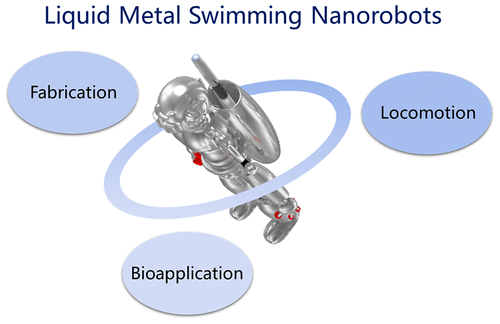当前位置:
X-MOL 学术
›
Acc. Mater. Res.
›
论文详情
Our official English website, www.x-mol.net, welcomes your feedback! (Note: you will need to create a separate account there.)
Liquid Metal Swimming Nanorobots
Accounts of Materials Research ( IF 14.6 ) Pub Date : 2021-12-07 , DOI: 10.1021/accountsmr.1c00233 Zesheng Li 1 , Jie Xu 1 , Zhiguang Wu 1 , Bin Guo 1 , Qiang He 1
Accounts of Materials Research ( IF 14.6 ) Pub Date : 2021-12-07 , DOI: 10.1021/accountsmr.1c00233 Zesheng Li 1 , Jie Xu 1 , Zhiguang Wu 1 , Bin Guo 1 , Qiang He 1
Affiliation

|
Room temperature liquid metal gallium-based materials have received tremendous attention owing to their potential promises in various aspects including bioengineering and smart medicine, flexible circuits and electronic skins, transformable activators and triboelectric nanogenerators, etc. Particularly, the usage of gallium-based liquid metals to construct humanoid robots to accomplish diverse dangerous missions leads to the considerable focus on the development of gallium-based flexible robots. Unlike conventional metal materials with rigid properties and responsible mainly for the backbone, room temperature gallium-based liquid metals could serve as a new generation of smart flexible materials for robotic devices with its advantages, such as low toxicity, high fluidity, and plasticity at the micro/nanometer sizes. With the expectation in biomedicine, such as targeted drug delivery, the past decade has led to the scaling down of the swimming robot to the micro- and nanoscales. Swimming nanorobots, which are defined as devices that can convert chemical energy in the surrounding environment and externally physical field into their own kinetic energy at the micro/nanoscale and achieve self-propulsion, have shown widespread potential in the field of in vivo applications. Despite the great promises, gallium-based liquid metal robots are primarily limited to the millimeter and subcentimeter scales. Moving toward clinical medical practices, however, these gallium-based liquid metal swimming robots are facing the biocompatible problem caused by their large sizes and propulsion approaches. Particularly, the manufacture, self-propulsion, and navigation of nanoscale liquid metal swimming robots, ensuring the penetration though various tissues toward the disease area, is still challenging. Construction of gallium-based swimming nanorobots is of vital importance both for fundamental research, such as the dynamics of individual nanorobots and emergence of nanorobotic swarms, as well as for engineering and bioapplications, for instance, active target delivery. When applied as an in vivo surgical agent, the gallium-based liquid metal nanorobots will not only gather into the disease site at a higher targeting ratio but also behave in an emerged collective means that transform and infuse to destroy the lesion by photothermal and photodynamic therapy, and so on. Compared with the large-scale liquid metal robots, gallium-based swimming nanorobots offer the advantages in treatment of tumors with lower intensity, navigation with higher precision, and surgical therapies with minor invasion.
中文翻译:

液态金属游泳纳米机器人
室温液态金属镓基材料因其在生物工程和智能医学、柔性电路和电子皮肤、可转换活化剂和摩擦纳米发电机等方面的潜在应用前景而受到广泛关注。特别是镓基液态金属的应用构建人形机器人以完成各种危险任务导致人们对基于镓的柔性机器人的开发产生了相当大的关注。与传统的具有刚性且主要负责骨架的金属材料不同,室温镓基液态金属具有低毒性、高流动性和可塑性等优点,可以作为机器人设备的新一代智能柔性材料。微米/纳米尺寸。随着对生物医学的期望,例如靶向药物输送,过去十年导致游泳机器人缩小到微米和纳米尺度。游泳纳米机器人被定义为能够将周围环境和外部物理场中的化学能转化为自身微/纳米尺度的动能并实现自我推进的装置,在游泳领域显示出广泛的潜力。体内应用程序。尽管前景广阔,但基于镓的液态金属机器人主要局限于毫米和亚厘米级。然而,走向临床医疗实践,这些基于镓的液态金属游泳机器人正面临着由其大尺寸和推进方式引起的生物相容性问题。特别是纳米级液态金属游泳机器人的制造、自推进和导航,以确保通过各种组织向疾病区域渗透,仍然具有挑战性。构建基于镓的游泳纳米机器人对于基础研究(例如单个纳米机器人的动力学和纳米机器人群的出现)以及工程和生物应用(例如主动目标递送)都至关重要。当应用为在体内手术药剂中,镓基液态金属纳米机器人不仅会以更高的靶向率聚集到病灶部位,而且会以一种新兴的集体方式表现,通过光热和光动力疗法转化和灌注破坏病灶等。 . 与大型液态金属机器人相比,镓基游泳纳米机器人具有治疗肿瘤强度低、导航精度高、手术侵袭小等优势。
更新日期:2022-01-28
中文翻译:

液态金属游泳纳米机器人
室温液态金属镓基材料因其在生物工程和智能医学、柔性电路和电子皮肤、可转换活化剂和摩擦纳米发电机等方面的潜在应用前景而受到广泛关注。特别是镓基液态金属的应用构建人形机器人以完成各种危险任务导致人们对基于镓的柔性机器人的开发产生了相当大的关注。与传统的具有刚性且主要负责骨架的金属材料不同,室温镓基液态金属具有低毒性、高流动性和可塑性等优点,可以作为机器人设备的新一代智能柔性材料。微米/纳米尺寸。随着对生物医学的期望,例如靶向药物输送,过去十年导致游泳机器人缩小到微米和纳米尺度。游泳纳米机器人被定义为能够将周围环境和外部物理场中的化学能转化为自身微/纳米尺度的动能并实现自我推进的装置,在游泳领域显示出广泛的潜力。体内应用程序。尽管前景广阔,但基于镓的液态金属机器人主要局限于毫米和亚厘米级。然而,走向临床医疗实践,这些基于镓的液态金属游泳机器人正面临着由其大尺寸和推进方式引起的生物相容性问题。特别是纳米级液态金属游泳机器人的制造、自推进和导航,以确保通过各种组织向疾病区域渗透,仍然具有挑战性。构建基于镓的游泳纳米机器人对于基础研究(例如单个纳米机器人的动力学和纳米机器人群的出现)以及工程和生物应用(例如主动目标递送)都至关重要。当应用为在体内手术药剂中,镓基液态金属纳米机器人不仅会以更高的靶向率聚集到病灶部位,而且会以一种新兴的集体方式表现,通过光热和光动力疗法转化和灌注破坏病灶等。 . 与大型液态金属机器人相比,镓基游泳纳米机器人具有治疗肿瘤强度低、导航精度高、手术侵袭小等优势。


























 京公网安备 11010802027423号
京公网安备 11010802027423号